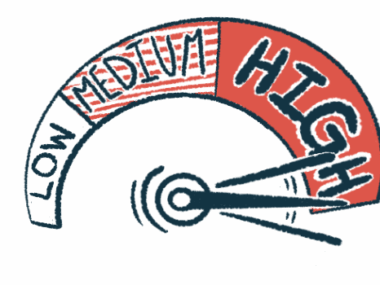Cushing’s tied to buildup of fat around heart, inside arteries: Study
Markers of inflammation may serve as indicators for coronary artery disease
Written by |

Individuals with Cushing’s syndrome have a greater buildup of fat around the heart and inside the coronary arteries — the blood vessels that supply blood to the heart — compared with people who don’t have the condition but who are at a higher risk of developing cardiovascular disease, according to a new study from China.
That study also found, however, that levels of inflammation were lower in Cushing’s patients — as determined by markers of inflammation and fatty tissue buildup surrounding the heart and blood vessels. These markers also are known to be associated with a higher risk of cardiovascular diseases.
The researchers noted, however, that these markers indicated that inflammation worsened with the progression of Cushing’s. That suggests they may be used as “indicators to monitor the development of coronary artery disease in [Cushing’s syndrome] patients,” the researchers wrote.
“More studies are needed to explore the effects of excessive cortisol [a Cushing’s hallmark] on calcified plaques in patients with [Cushing’s syndrome],” the scientists wrote.
The study, “Epicardial and pericoronary adipose tissue and coronary plaque burden in patients with Cushing’s syndrome: a propensity score‑matched study,” was published in the Journal of Endocrinological Investigation.
Diagnostic test used to produce detailed images of coronary arteries
Cushing’s syndrome refers to conditions driven by high cortisol levels. Most commonly, it’s caused by a tumor in the pituitary gland, which produces excessive amounts of adrenocorticotropic hormone (ACTH), a signaling molecule that controls cortisol production in the adrenal glands. In such cases, it is called Cushing’s disease.
High accumulation of visceral adipose tissue — the fat that lines internal organs — is a common feature of Cushing’s. Excessive visceral fat may raise a patient’s risk of cardiovascular disease by increasing inflammation and promoting the accumulation of fat, or plaques, on artery walls, called atherosclerosis.
According to the researchers, however, few studies have reported a higher accumulation of fat around the heart muscle, known as epicardial adipose tissue, or EAT, and around blood vessels — called perivascular adipose tissue — in people with Cushing’s syndrome.
Here, the team also looked at the perivascular fat attenuation index, or FAI, a marker of coronary artery inflammation that’s associated with the risk of coronary disease.
“Whether individuals with [Cushing’s syndrome] can benefit from the use of recognized markers for metabolic and cardiovascular risks, such as EAT and FAI remains unclear,” they wrote.
To know more, the team of researchers, from Shanghai, sought to assess whether changes in EAT, perivascular FAI, or coronary plaque burden could be used to assess coronary inflammation in Cushing’s patients.
To that end, they used a diagnostic test called CCTA, for coronary computed tomography angiography, to produce detailed images of the coronary arteries. These images also show how blood flows through the heart.
A total of 29 Cushing’s patients, mostly women (69%) and with a mean age of 56, were included in the study, along with 58 matched controls. The controls were individuals without Cushing’s who were referred for CCTA due to chest pain, increased cardiovascular risk, and/or abnormal results in an electrocardiogram. That test, often called an ECG or an EKG, is commonly used to evaluate the heart’s electrical activity.
Among the Cushing’s patients, 13 had Cushing’s disease, one had a tumor in the thymus, and 15 had tumors in the adrenal glands.
Higher volume of fat around heart found for Cushing’s patients
The scientists compared parameters regarding fat tissue buildup around the heart and coronary arteries. They used the Hounsfield scale, which measures tissue density in CT scans.
Cushing’s patients were found to have a significantly higher EAT volume (146.9 vs. 119.6 mL), but lower density (-78.8 vs. -76 Hounsfield units, or HU), and lower FAI (-86.7 vs. -80.1), as compared with the controls.
Moreover, the total fat plaque volume in coronary arteries (88.8 vs. 44.5 mm3) and non-calcified plaques (78.3 vs. 27.5 mm3) were significantly higher in Cushing’s patients. Non-calcified plaques are associated with a higher risk of adverse cardiovascular events.
These findings indicated that although Cushing’s patients had a higher volume of fat around the heart and a higher coronary plaque burden, they had lower levels of inflammation, as indicated by FAI and EAT density.
Further studies … may be helpful for better [assessing] cardiovascular disease risk and management in patients with [Cushing’s syndrome].
For six patients, two CCTA examinations were available with a time interval of 31 months, or about 2.5 years. The follow-up exam showed that EAT volume, FAI, and plaque burden had increased with time in these patients.
A multivariate analysis, which takes into account several variables, suggested that Cushing’s syndrome, its duration, and the levels of free cortisol in the urine were strongly associated with EAT volume, but not EAT density.
“Considering the complex [disease-causing] processes in the adipose tissue of … [Cushing’s syndrome patients], the EAT density and FAI may not be pertinent indicators of cardiovascular disease risk [in these patients],” the researchers wrote.
However, they may be useful indicators to monitor the development of coronary disease risk in Cushing’s patients over time, they noted.
“Further studies concerning the pericardial fat … may be helpful for better [assessing] cardiovascular disease risk and management in patients with [Cushing’s syndrome],” the team concluded.







